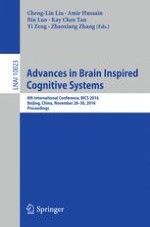2016 | Buch
Advances in Brain Inspired Cognitive Systems
8th International Conference, BICS 2016, Beijing, China, November 28-30, 2016, Proceedings
herausgegeben von: Cheng-Lin Liu, Amir Hussain, Bin Luo, Kay Chen Tan, Yi Zeng, Zhaoxiang Zhang
Verlag: Springer International Publishing
Buchreihe : Lecture Notes in Computer Science
